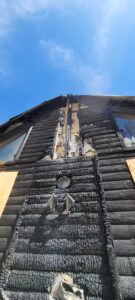Log homes are beautiful, cozy, and natural, but they also come with some challenges. Fire safety is a significant concern for those who own log homes. While log homes have better fire-resistant ratings than standard homes, they still pose a concern, especially in areas prone to wildfires. Due to the repair cost and proximity to high-risk wildfire areas, insurance for a log home is usually more expensive. Log homes are made of wood, a combustible material that can easily catch fire and spread flames. In fact, according to the National Fire Protection Association, wood or log wall construction was the leading material first ignited in home fires in 2019. Fire retardant varnish is an essential way to protect your log home from fire.

What is Fire Retardant Varnish?
Fire retardant varnish is a type of coating that reduces the flammability of wood and other combustible surfaces. It forms a protective layer that prevents oxygen from reaching the wood, slowing down or stopping the combustion process. Fire retardant varnish can prevent the spread of fire to other areas by reducing the heat and smoke generated by burning wood.

Fireproof varnish is a misleading term implying that the coated surface is immune to fire, which is false. Although varnish cannot entirely prevent the wood from burning, fire retardant varnish can significantly delay or reduce the damage to the wood.
The formulation of fire retardant varnish varies depending on its intended use and application method.
Some common types are:
- Class A Varnish System: This is a two-coat system that consists of a base coat and a top coat. The base coat contains fire-retardant chemicals that penetrate the wood and form a barrier against fire. The topcoat provides a durable and attractive finish that seals the base coat and protects it from moisture and UV rays. This system is suitable for most interior combustible surfaces, except floors2.
- Flamex PF-2: You can use this single-coat system, designed for exterior wood surfaces. It contains fire retardant additives that create a water-resistant film on the wood, preventing it from drying out and becoming more flammable. This system is recommended for reapplication every 2-5 years, depending on rainfall amount3.
- Flame Control Varnishes: These decorative and protective coatings comply with building and fire codes and give substrate-rated flame spread protection. They appear like traditional paints and varnishes and are available in different sheens, such as low, semi, and high-gloss4.
Why You Need Fire Retardant Varnish for Your Log Home
Interior and Exterior Stain Differences
Caulk Before or After Stain
Are you interested in a log home restoration and maintenance career? You can learn more here.
